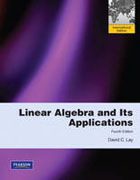
Linear algebra is relatively easy for students during the early stages of thecourse, when the material is presented in a familiar, concrete setting. But when abstract concepts are introduced, students often hit a brick wall. Instructors seem to agree that certain concepts (such as linear independence, spanning, subspace, vector space, and linear transformations), are not easily understood, and require time to assimilate. Since they are fundamental to the study of linear algebra, students' understanding of these concepts is vital to their mastery of the subject. David Lay introduces these concepts early in a familiar, concrete Rn setting, develops them gradually, and returns to them again andagain throughout the text so that when discussed in the abstract, these concepts are more accessible. INDICE: 1. Linear Equations in Linear Algebra Introductory Example: LinearModels in Economics and Engineering 1.1 Systems of Linear Equations 1.2 Row Reduction and Echelon Forms 1.3 Vector Equations 1.4 The Matrix Equation Ax = b1.5 Solution Sets of Linear Systems 1.6 Applications of Linear Systems 1.7 Linear Independence 1.8 Introduction to Linear Transformations 1.9 The Matrix ofa Linear Transformation 1.10 Linear Models in Business, Science, and Engineering Supplementary Exercises 2. Matrix Algebra Introductory Example: Computer Models in Aircraft Design 2.1 Matrix Operations 2.2 The Inverse of a Matrix 2.3Characterizations of Invertible Matrices 2.4 Partitioned Matrices 2.5 Matrix Factorizations 2.6 The Leontief Input--Output Model 2.7 Applications to Computer Graphics 2.8 Subspaces of Rn 2.9 Dimension and Rank Supplementary Exercises3. Determinants Introductory Example: Random Paths and Distortion 3.1 Introduction to Determinants 3.2 Properties of Determinants 3.3 Cramer's Rule, Volume, and Linear Transformations Supplementary Exercises 4. Vector Spaces Introductory Example: Space Flight and Control Systems 4.1 Vector Spaces and Subspaces4.2 Null Spaces, Column Spaces, and Linear Transformations 4.3 Linearly Independent Sets; Bases 4.4 Coordinate Systems 4.5 The Dimension of a Vector Space 4.6 Rank 4.7 Change of Basis 4.8 Applications to Difference Equations 4.9 Applications to Markov Chains Supplementary Exercises 5. Eigenvalues and Eigenvectors Introductory Example: Dynamical Systems and Spotted Owls 5.1 Eigenvectors and Eigenvalues 5.2 The Characteristic Equation 5.3 Diagonalization 5.4 Eigenvectors and Linear Transformations 5.5 Complex Eigenvalues 5.6 Discrete Dynamical Systems 5.7 Applications to Differential Equations 5.8 Iterative Estimates for Eigenvalues Supplementary Exercises 6. Orthogonality and Least Squares Introductory Example: Readjusting the North American Datum 6.1 Inner Product, Length, and Orthogonality 6.2 Orthogonal Sets 6.3 Orthogonal Projections 6.4 The Gram--Schmidt Process 6.5 Least-Squares Problems 6.6 Applications to Linear Models 6.7 Inner Product Spaces 6.8 Applications of Inner Product Spaces Supplementary Exercises 7. Symmetric Matrices and Quadratic Forms Introductory Example: Multichannel Image Processing 7.1 Diagonalization of Symmetric Matrices 7.2Quadratic Forms 7.3 Constrained Optimization 7.4 The Singular Value Decomposition 7.5 Applications to Image Processing and Statistics Supplementary Exercises 8. The Geometry of Vector Spaces Introductory Example: The Platonic Solids 8.1 Affine Combinations 8.2 Affine Independence 8.3 Convex Combinations 8.4 Hyperplanes 8.5 Polytopes 8.6 Curves and Surfaces 9. Optimization (Online Only) Introductory Example: The Berlin Airlift 9.1 Matrix Games 9.2 Linear Programming--Geometric Method 9.3 Linear Programming--Simplex Method 9.4 Duality 10. Finite-State Markov Chains (Online Only) Introductory Example: Google and MarkovChains 10.1 Introduction and Examples 10.2 The Steady-State Vector and Google's PageRank 10.3 Finite-State Markov Chains 10.4 Classification of States and Periodicity 10.5 The Fundamental Matrix 10.6 Markov Chains and Baseball Statistics Appendices A. Uniqueness of the Reduced Echelon Form B. Complex Numbers
- ISBN: 978-0-321-62335-5
- Editorial: Addison-Wesley
- Encuadernacion: Rústica
- Páginas: 576
- Fecha Publicación: 01/01/2011
- Nº Volúmenes: 1
- Idioma: Inglés
- Inicio /
- MATEMÁTICAS /
- ÁLGEBRA
